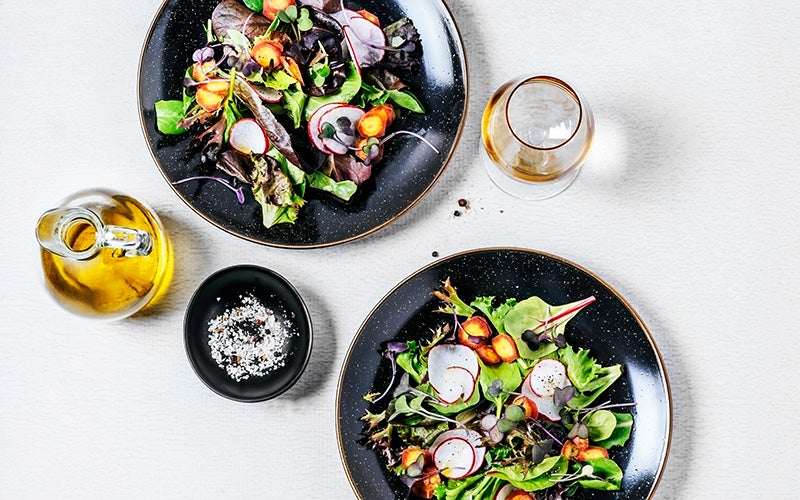4 Creative Ways to Estimate Your Ideal Serving Size
 ©Claudia Totir
©Claudia Totir
A bowl of fruit oatmeal for breakfast, a big plate of protein pasta with tomato sauce for lunch, a colorful chicken salad for dinner, and a protein bar for a snack—that’s what a day of eating might look like for you. But how do you know exactly how much to eat to stay full? And are you actually eating enough? In this article, we’ll explain everything you need to know to find the best serving size for your needs.
First, a disclaimer: Before we get to the heart of the matter, we want to remind you that every person is different and has different nutritional needs. The information in this article has been formed around general nutritional guidance, but is not meant as a prescription for any single person. If you’re worried that you may have a deficiency or are interested in reducing your serving size, always talk to your doctor before making any changes in your diet.
How Many Servings Should We Eat?
All aspects of your life have an impact on how much food you need, from your work schedule to your social habits. Some people prefer to eat 2 to 3 large meals a day, while others function better with 4 to 6 small ones. Whether you choose the former or the latter, portion size plays an important part in how we feel, and both ways of eating have advantages and disadvantages.
The Food Pyramid
By now we’re all familiar with the food pyramid. One version, designed by AID (the German agency for consumer information), uses the colors red, yellow, and green to demonstrate the serving size of each food that we need every day. Each of the six columns is categorized by the number of recommended servings and their corresponding portion size. (1)

Additionally, the 3D food pyramid designed by the German Nutrition Society takes the quality of products into account along with food groups and serving sizes. (2)
Serving Size in Grams
Grams are almost always used to describe serving sizes. A main course with three components—like meat, vegetables, and grains—should weigh an average of 400 to 550 grams to satisfy an adult. However, the amount of calories in a dish doesn’t always correlate to its weight in grams. That’s because some calorie-dense ingredients aren’t heavy, while other, less-caloric foods weigh a lot. For example, a spoonful of peanut butter could have up to 200 calories, while the same amount of celery will contain practically none at all.
The following table will give you an idea of how many grams of a certain food group to eat in a meal.
| Foods | Serving size in grams |
| Meat (chicken, steak, pork) | 150 to 180 grams per serving |
| Carb-rich side dish (potatoes, pasta, rice) | 200 grams per serving, cooked |
| Vegetable side dish (broccoli, zucchini, carrots) | 200 grams per serving, cooked |
| Vegetables as a main dish | 300 to 400 grams per serving |
| Fruit (bananas, apples, grapes) | 120 to 150 grams per serving |
| Salads (tomato and potato salad) | 120 to 150 grams per serving |
| Desserts (cakes, pies, cookies) | 120 to 150 grams per serving |
How to Use Your Hands to Measure Serving Sizes
If you’re still not sure how much of what you should be eating, take a look at your hands. The amount that can fit into your palm, finger, or whole hand is how large each serving size should be, according to general recommendations. This is how many servings of different food groups you need to eat each day.
- 3 servings of vegetables
- 2 servings of fruit
- 4 servings of carbs
- 1 serving of protein
- 2 servings of healthy fat sources
While some servings are the size of your entire hand, others are only the size of your finger because they’re more calorie and nutrient dense. Here’s a clever rule of thumb (get it?) to help measure healthy portion sizes look like for different food groups on a healthy eating plan.
- the palm of your hand = 1 serving of protein
- the tip of your thumb = 1 serving of fat
- the size of your fist = 1 serving of carbs
- the inside of both hands cupped together = 1 serving of fruit or vegetables
The advantage of this method is that your hand grows with you, so you have the right measurements for the different nutritional needs you’ll have throughout your life. When you’re younger and the amount of food you need is smaller, both your serving and hand sizes should be smaller. When you’re older and your hand grows, so does the amount of food you need to eat. Unfortunately this trick doesn’t always work for everyone, especially adults with particularly small or large hands.
Measure Serving Sizes with Your Plate
If your hand is too small or big, or you’d simply prefer to measure serving sizes another way, then the plate method is for you. It simply requires you to divide your plate into three parts, something you probably already do for dinner most nights!
Start by filling half the plate with fruits and vegetables. You can practically never have enough of this food group, so feel free to bulk up the portion size if you’re feeling really hungry. Then, add one quarter carbs and one quarter protein and dig in! This should be more than enough to keep you satisfied.
Having trouble meeting your protein needs on your own? One 30g serving of our Organic Protein contains a whopping 20g of protein. And it can easily be added to just about anything, from smoothies to oatmeal.
Measuring Serving Sizes to Lose Weight
In order to lose weight, you need to burn more than you take in. That’s why it’s often necessary to reduce your caloric intake by 300 to 500 calories a day to do so. For reference, an 80g serving of pasta contains about 280 calories.
Before cutting any calories, find out more about the calories behind one portion size of tons of everyday foods. It’s all in our calorie charts!
Serving Sizes on Nutrition Facts Label
You’re probably wondering what to make of the portion sizes on nutrition facts label with all this new information. Every supermarket product displays its serving size in both grams and calorie usually on the back of the package. There, you’ll also find info about the quantity of macronutrients like carbs, protein, and fat as well as micronutrients like iron.
In addition to telling you the nutrition facts label of a product per 100g, it will also tell you what you’re getting from a full serving size. Sometimes there’s a difference between the two because certain foods are more calorie dense than others. For example, a portion of muesli can range anywhere from 30 to 80g depending on what it contains. You’ll be surprised at how different the food labels on the same type of product can be.
The other problem is that every serving size isn’t uniformly regulated. When in doubt, follow your gut to figure out exactly what amount of food you need. And if you can’t eat everything on your plate, save it for later!
Our Conclusion
- There are many different ways to measure serving size, but here are four of the most popular methods.
- The food pyramid makes it easy to visualize what quantity of certain food groups is a healthy portion size.
- Serving size can vary from ingredient to the next because some are more calorie dense than others, so don’t always depend on the nutrition facts label.
- You can use your hand to figure out the right serving size for your needs. .
- Using your plate to divide your food groups makes it easier to be sure you’re getting the right portion size.
Sources for this article
We at foodspring use only high-quality sources, including peer-reviewed studies, to support the facts within our articles. Read our editorial policy to learn more about how we fact-check and keep our content accurate, reliable, and trustworthy.






















